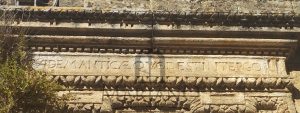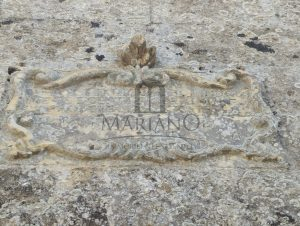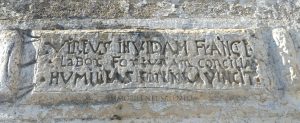Through the Landscapes of Salento, among centuries-old olive groves and dry-stone walls, where narrow alleys wind between golden stone houses and carved portals, there exists a discreet and fascinating universe that often escapes the hurried gaze of visitors: the world of domestic epigraphs—phrases engraved into the stone of homes, especially in the historic centers of Salento’s villages.
The Voice of Stone
These epigraphs are not mere decorations. They are the living voice of a rural civilization that, even with limited means, did not forgo the desire to leave an eternal trace of its thoughts, its faith, its values. Created by local stonemasons, they were carved into architraves, doorposts, courtyards, and columns, blending seamlessly with the area’s typical architecture.

In these villages, every old house is a history lesson: Lecce stone or carparo masonry, star-shaped vaults, monumental fireplaces, Baroque portals—and, indeed, engraved epigraphs that reveal the soul of those who lived there.
A house in Specchia bears the inscription:
“He who works has no time to do evil”
Carved in 1912, it speaks of a work ethic. In Montesardo, on a doorway:
“Peace is a wealth that money cannot buy”
In Giuliano di Lecce, an entire street is rich with epigraphs—each unique, metaphorical, and deeply meaningful:
-
“See what is in the bag behind your back”
(A call to recognize our own flaws before judging others) -
“Do not love sleep, lest poverty oppress you. What you save, let it be gain for your heir. In the year of Our Lord 1778”
-
“Virtue destroys envy, work brings good fortune, humility overcomes hardship”
-
“The master built it not in hope of profit, but of freedom, in the year of Our Lord 1789”
(The owner built the oil mill during the year of the French Revolution—not out of greed, but to honor the ideals of liberty) -
“Endure, and save yourselves for better times — Donato Serracca, in the year of Our Lord 1854”
(From Book I of Virgil’s Aeneid, a message of optimism for those in hardship)
 Between the Sacred and the Secular
Between the Sacred and the Secular
These inscriptions also reflect the deep spirituality of this land. Often, one finds invocations in Latin or archaic Italian:
“Ave Maria gratia plena”
“In Deo spes mea”
Short but powerful phrases, placed above the entrance as both blessing and shield.
Salento’s architecture, built from humble yet ingenious materials, is enriched by these sculpted words that protect and tell stories.
Stone as Canvas
In Salento, stone is not just a construction material—it is a narrative surface, a carved page, a voice that does not age. Epigraphs are born and live within an architecture entirely shaped by the gifts of the land: pietra leccese, carparo, tufo. These pliable, living elements are transformed into architraves, columns, vaults—and also into enduring messages.
Lamia houses with barrel vaults, courtyard homes, underground oil mills, dovecote towers: every structure, no matter how humble, offered space for a phrase, a maxim, an invocation.
Where today a modern home might display an anodized plaque, in the past people wrote on stone with hammer and chisel, etching messages with the same care they used to shape cornices or balcony brackets. Writing became part of the architecture—a unique language in which matter and spirit coexisted. Ornament became meaning. And the house, more than just a refuge, became an existential statement.
Memory and Identity

Each epigraph tells more than what the words say—it tells of an era, a mindset, a worldview. It is memory carved into stone, and also a declaration of identity. In a region where architecture has evolved without losing touch with tradition, these inscriptions represent a cultural continuity across generations.
They are never separate from the form that houses them: they follow the contour of a portal, the rhythm of an arch, the height of a window. In doing so, they become a living part of the architectural body, integrated elements rather than additions.
Where a contemporary house may speak through color, materials, or design, a Salento house speaks through its stones. And among those stones, the carved words become a silent yet eloquent signature—not just of an individual, but of an entire community, a social and cultural fabric that continues to speak.
A Voice to Preserve
Time, with its patina, often does not erase these inscriptions. But neglect does. Some have been lost to hasty restorations, others still wait to be rediscovered beneath plaster or vegetation. Thankfully, there is today a renewed interest in this heritage: architects, restorers, thoughtful buyers, and sensitive travelers recognize these engravings as treasures worth preserving.
To preserve them, to respect them, or even to draw inspiration from them for new inscriptions is more than an aesthetic choice. It is an act of cultural continuity—a way to honor the soul of a place and carry it into the future without betraying its roots.
To let stone speak again today means to listen closely to the voices of the past—and to add, with care, new words that do not erase the old ones but accompany them, like a dialogue between generations.
Conclusion
In Salento, epigraphs are small miracles of stone and word. They reflect the wisdom of those who lived with little, but with dignity. Reading them is like hearing a gentle voice that reminds us of what truly matters: peace, faith, family, work.
When you walk through the historic centers of Salento, look up—the stones know how to speak. And they speak with Salentine wisdom.



